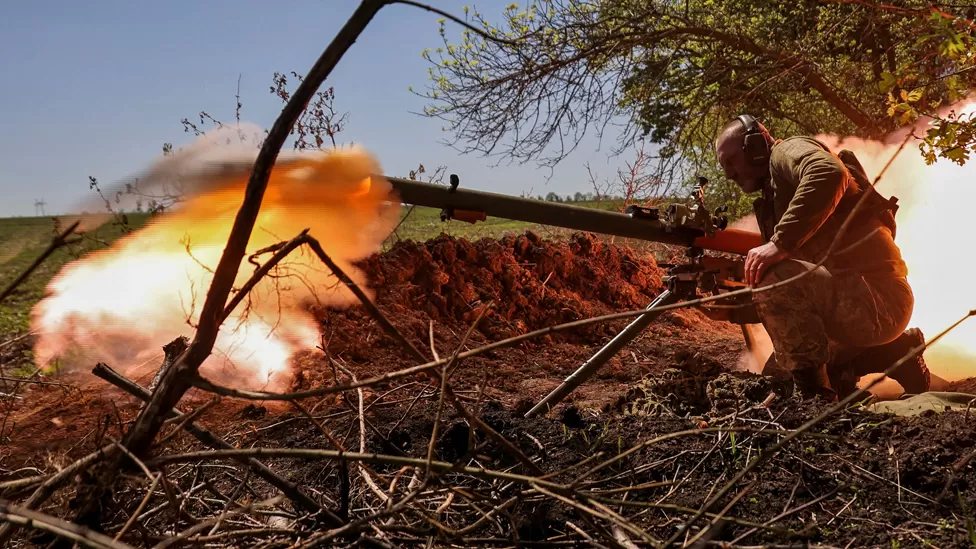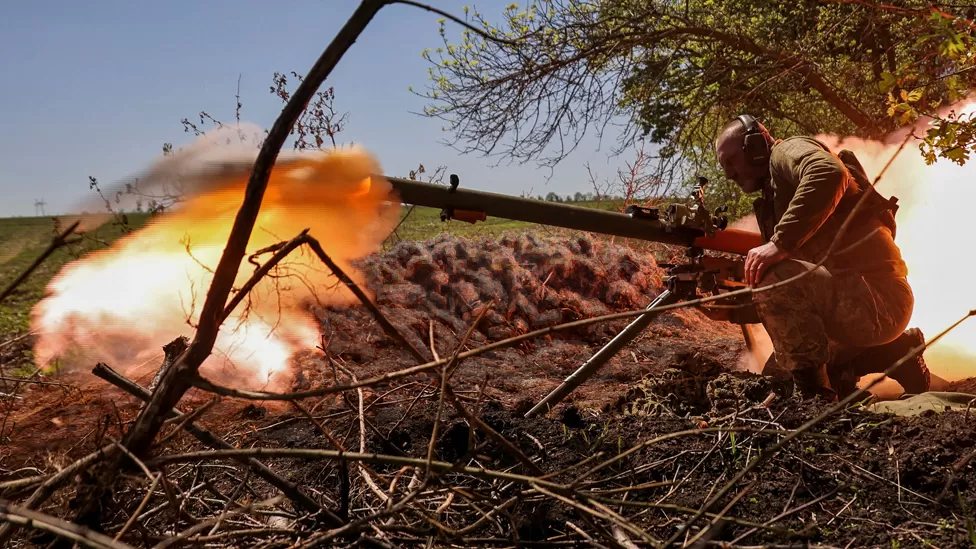
The photo above is an obvious fake. I’m an untrained amateur, but the image is clearly a digitally modified composite using several layers (at least two or three) that have been sloppily merged.
It accompanied an article about Ukraine that was published yesterday by the BBC. The article itself is irrelevant; it’s just the usually boilerplate propaganda one expects from the MSM. What interests me is the photo.
The background is a shot of a sunlit field at midday during springtime. The foreground is probably composed of two distinct layers: the soldier shooting the grenade launcher next to a pile of dirt, and the pile of branches close to the camera. At least some of the fire and smoke associated with the firing of the weapon has been created digitally.
The soldier and the branches in the foreground were evidently photographed under a floodlight at night or during twilight. The pile of dirt beyond the soldier was outside the main glare of the floodlight, and was thus lit only by the blast from the grenade launcher — that is, backlit in orange and red.
It’s that last point that makes the image such an obvious fake: the pile of dirt does not share the same light source as the field beyond it. The technician who was assigned the job of creating the digital fake was either inept, careless, or untrained in the digital manipulation of images, or some combination of all three. It was a slipshod production, and Reuters and the BBC just let it slide on through.
But there is a fourth possibility: the composite image may have been created with deliberate incompetence, as an insult to the reader, as if to say: “We hold you in such contempt that we insult your intelligence by presenting you with this obvious fake. Deal with it.”
It brings to mind the well-known quote from Theodore Dalrymple:
In my study of communist societies, I came to the conclusion that the purpose of communist propaganda was not to persuade or convince, not to inform, but to humiliate; and therefore, the less it corresponded to reality the better. When people are forced to remain silent when they are being told the most obvious lies, or even worse when they are forced to repeat the lies themselves, they lose once and for all their sense of probity. To assent to obvious lies is in some small way to become evil oneself. One’s standing to resist anything is thus eroded, and even destroyed. A society of emasculated liars is easy to control.
As I said, I’m an amateur when it comes to digital manipulation, but even I could do better than the Reuters snoid who made this image. It took me just a few minutes to adjust the light on the upper surfaces in the pile of dirt to make it more plausibly in agreement with the sunlit field beyond:

A lot more needs to be done, however, to make this product even minimally convincing. The floodlight used to illumine the soldier, his weapon, and the branches was sufficiently bright, and coming from more or less the right direction, but the shadows are too dark — the chiaroscuro is too extreme. Natural sunlight from the same angle would provide a lot of backscatter from the surrounding landscape to soften the darkness of the shaded areas.
The fire and smoke are obvious fakes that cut off too abruptly against the blue sky. To be convincing, the sky and background should have been more obscured, and the nearby branches of trees should have been roiled by the blast.
The blast itself has problems, particularly the strange orange aura that passes between the soldier’s weapon and the camera.
I spent some time discussing this image with Vlad (who thought up the title for this post), and he says he knows exactly how the fire was created. He has used software that makes fake fire and explosions for digital productions, and he’s certain that the creator of the image was using something similar.
It’s his opinion that the original photo of the soldier and his weapon was created by the manufacturer to advertise the product, and was adapted to produce a fake propaganda photo to promote the war in Ukraine. He could well be right.
But it’s the pile of dirt that clinched it for me. It is most definitely NOT lit by the same light source as the background.
And the BBC doesn’t mind using an obvious fake.
Such is the sorry pass to which the mainstream media have come in this dystopian third decade of the 21st century.

That thing looks too big to be an RPG; perhaps it’s some kind of recoilless rifle. Those were pretty common in the Korean and Vietnam wars but a big problem with them was the massive backblast from the nature of the round they used and how it was vented, and being a direct fire weapon they also would kick up a lot of dust.
What gives it away for me is the lack of disturbance to the vegetation in front of and to the side of the muzzle, which should be considerable firing it that close to those bushes. During gunnery practice on the Abrams tank, when we were outside waiting for our turn on the firing line and that cannon would fire, there was a substantial pressure wave generated that caused the ground to jump in front of the muzzle and the effect also made the air appear to vibrate. That blast in the photo should have blurred everything around it.
But seeing as this photo is geared towards the gullible batch of morons who believe Ukraine is winning the war, the bar for plausibility of this type of propaganda is quite low.
Yes a 106 mm recoiless rifle a weapon gone too soon. Great to give anti armor support to grunts. We used them in Hue City to bust up entrenched Nva in buildings.
I read a really good book about the battle for Hue that mentioned the use of recoilless rifles for that purpose.
Apparently there was some kind of improvised vehicle; I don’t recall if it was wheeled or tracked, that had about half a dozen of those mounted on it and was used to very good effect for leveling buildings.
It’s quite a fascinating weapon. I read all I could find on them when I was in my teens. Which wasn’t very much, that being pre-internet. I always found it an extremely clever and elegant design regarding how they used a perforated case and angled venturis at the rear of the breech to balance the weight of the shell as well as the torque of the rifling.
Good that you made it through that battle, which seemed to have become overshadowed by the rest of the Tet Offensive.
The vehicle was named ‘Ontos”. 6 106mm recoilless rifles. mounted 3 on a side. Used by the US Marines. Don’t think US Army ever had any.
‘Toddlers (aka commie-toddlers) LIE and LIE and LIE and, then, they LIE about their LIES. There’s no law that can’t be broken, no lie that can’t be told by these anti-American Bolshevik two year-old commie-toddlers in their blind pursuit of ‘social justice’ (for personal gain). Armies of squirrels must be unleashed to eat them all.
Also, the edges of the smoke on the left are striped.
But hey, nothing what’s actually happening in this Potemkin World is what we are being told or shown…
Nearly everything that you see or read in the media about Ukraine and Russia nowadays is a bunch of lies. It is next to impossible to understand what is going on if you have only the media as your source of information.
It’s a shame. Let them use the neural network, it tracks light and shadow better. Free neural network! Not to mention paid.
The only difficulty is to generate jihadists without pants (this is very offensive!). Often a content ban is issued. But I have learned to get around it.
But it perfectly generates jihadists with donkey ears! No problem.
It’s a Soviet-era 73mm SPG-9 Kopyo recoilless gun, or a derivative.